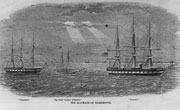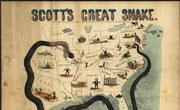Please check back later for more on this topic.
Please check back later for more on this topic.
Please check back later for more on this topic.
Please check back later for more on this topic.
Please check back later for more on this topic.
Please check back later for more on this topic.
Union Blockade

Three sailing ships: 'Vandalia', the prize 'Arthur Middleton', and 'Roanoke'.

Gen. Winfield Scott's plan to crush the Confederacy
On April 19, 1861, President Abraham Lincoln announced the establishment of a Union blockade of Confederate ports. The purpose of the blockade was to prevent the import of essential supplies, as well as the export of cash crops, into and out of the Confederacy. The plan was designed to weaken the South and force the Confederacy to surrender and rejoin the Union.
As a result of the blockade, infections and disease were made worse by lack of drugs and a scarcity of Southern pharmaceutical laboratories. In 1862 Surgeon General Samuel Preston Moore tasked Dr. Francis Peyre Porcher with writing Resources of the Southern Fields and Forests, which identified native plants with therapeutic qualities that could be used in place of imported manufactured drugs.
Throughout the war, Confederate blockade-runners managed to import some drugs from Europe. The capture of Union supplies also served as a source of some medicines. However, because of few reliable sources of drugs the Confederate Army established medical laboratories in cities across the South, including one in Columbia, South Carolina. The Columbia facility, directed by Dr. Julian John Chisolm (MCSSC Class of 1850), opened sometime between mid-1862 and mid-1863. Confederate medical laboratories manufactured drugs, such as ether and chloroform, as well as experimented with native plants in order to produce remedies that could replace crucial medicines that were difficult to import, such as quinine.
Before Union troops ransacked and burned the city on February 17, 1865, Dr. Chisolm distributed some of the Columbia laboratory stock to hospitals, evacuated other supplies to Greenville, SC, with portions sent to Charlotte and Lincolnton, North Carolina. Remaining items, specifically medicinal alcohol, were destroyed. In April 1865, at the order of Surgeon General Moore, Dr. Chisolm sent supplies of quinine, silver nitrate, chloroform, and mercurial-pill mass to Moore in Augusta, Georgia. In June 1865, Dr. Chisolm relinquished to a Union officer all that was left from the Confederate laboratory in Columbia.
References
Bollett, A. J. (2002). Civil war medicine: Challenges and triumphs. Tucson, Arizona: Galen Press, LTD.
Hasegawa, G. R., & Hambrecht, F. T. (2003). The confederate medical laboratories. Southern Medical Journal, 96(12), 1221-1230.
Schroeder-Lein, G. R. (2008). The encyclopedia of civil war medicine M.E. Sharpe, Inc.